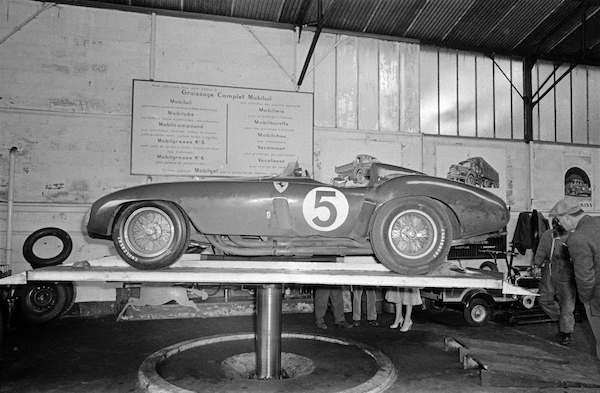
Raised on a workshop pedestal in a garage in the town of Le Mans is one of the three Scudeia Ferrari entries of the factory’s so-called 121LM, an in-line six cylinder sports car of 4.4 liters displacement. This work is taking place after practice as the car shows some post-running wet weather effects on its bodywork. This entry would be driven by Maurice Trintignant and Harry Schell. The nomenclature of 121LM, now in general use, derives from Ferrari’s engine type designation, although contemporary Ferrari records sometimes referred to these 4.4 liter six cylinder sports car as 735-6c, 735LM or 446S. Only four of these six cylinder sports racers were created for 1955, the first of which began life as a short wheelbase prototype for the series. It had been the only one of the sixes to finish the 1955 Mille Miglia (in third place) but was not entered for Le Mans because it was already being prepared and rebodied for Tony Parravano who would purchase it and take it back to California to add to his large and active stable of racing cars.
Le Mans saw the ultimate expansion of the six cylinder motor, as earlier in the year these cars were usually fitted with a 3.8 liter version. These sixes were designed by Aurelio Lampredi who had worked at Ferrari since the late 1940s. He designed a series of in-line four cylinder motors which powered Alberto Ascari to two world championships in 1952 and 1953 under the then two liter F2 regulations. In 1953 that same motor, which would be enlarged several times, would power a successful series of sport cars including the 1955 three liter 750 Monza. To make a yet more powerful and larger displacement version of his four, Lampredi literally added two more cylinders at the back of his four. It was not until the sixes began to appear that a cooling problem arose. This was most probably a combination of an undamped six cylinder harmonic combined with a lack of support for the extended crankcase and block/head assembly because the engine mount positions of the four continued to be used in exactly the same positions on the six which left the two extra cylinders hanging unsupported off the back of the motor. Carroll Shelby once told me that Luigi Chinetti had welded the flywheel onto the crankshaft of the 121LM Shelby drove in a step to prevent that harmonic from causing the flywheel to dislodge from its crankshaft.
 All three of the “big sixes” failed to finish and all suffered the same.malady – overheating from loss of water (rather than the clutch failure often reported). The Trintignant/Schell car, as seen here in the pits before the race, was the last of the trio to retire at about ⅓ distance. Le Mans was the last major European race for these sixes. Lampredi would soon be fired and Ferrari would become the home for the cars of the Lancia F1 team and their designer Vittorio Jano.
All three of the “big sixes” failed to finish and all suffered the same.malady – overheating from loss of water (rather than the clutch failure often reported). The Trintignant/Schell car, as seen here in the pits before the race, was the last of the trio to retire at about ⅓ distance. Le Mans was the last major European race for these sixes. Lampredi would soon be fired and Ferrari would become the home for the cars of the Lancia F1 team and their designer Vittorio Jano.
The three 121LMs at Le Mans would also find their was to America for more racing but little success.
Photos by Ami Guichard ©The Klemantaski Collection – http://www.klemcoll.com
To see more photos from our archive go to: http://www.klemcoll.com/TheGallery.aspx

This is Ron Parravano, Tony’s younger son. My website, ScuderiaParravano.com, opens with a photo of the 121LM when my father took delivery of the car at the Ferrai Factory. In the backrgound of the image is Carroll Shelby. Please vist the website for additional images from the Parravan Family Collection.
LikeLike